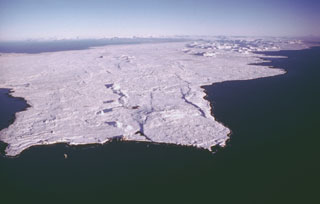Report on Reykjanes (Iceland) — 27 November-3 December 2024
Smithsonian Institution / US Geological Survey
Weekly Volcanic Activity Report, 27 November-3 December 2024
Managing Editor: Sally Sennert.
Please cite this report as:
Global Volcanism Program, 2024. Report on Reykjanes (Iceland) (Sennert, S, ed.). Weekly Volcanic Activity Report, 27 November-3 December 2024. Smithsonian Institution and US Geological Survey.
Reykjanes
Iceland
63.817°N, 22.717°W; summit elev. 140 m
All times are local (unless otherwise noted)
The Icelandic Meteorological Office (IMO) reported that the eruption that began on 20 November at the Sundhnúkur crater row in a location between Stóra-Skógfell and Sýlingarfell, within the Reykjanes volcanic system, continued during 26 November-3 December. Lava erupted from a single cone and slowly traveled E and SE towards and alongside Fagradalsfjall. The lava flow field near Fagradalsfjall thickened and slightly expanded; advancement of the lava flow front was slow. The average flow rate was estimated to be 11 cubic meters per second during 23-28 November, based on measurements taken by the Icelandic Institute of Natural History, and 5-10 cubic meters per second during 28-29 November. The sulfur dioxide emission rate on 28 November was 64-71 kg/s or about 5,500-6,100 tons per day. Gas plumes rose 500-800 m a.s.l. Deformation data showed minimal daily changes and suggested that magma input into the accumulation zone beneath Svartsengi was similar to the lava effusion rate. On 28 November Icelandic Institute of Natural History experts, who conducted field measurements and an aerial survey, concluded that lava covered an area of 9.2 square kilometers, had an approximate volume of 47 million cubic meters, and averaged 5 m thick. The eruption was the second largest by volume among eruptions at the Sundhnúkur Crater Row since December 2023. The Aviation Color Code remained at Orange (the second highest level on a four-color scale).
Geological Summary. The Reykjanes volcanic system at the SW tip of the Reykjanes Peninsula, where the Mid-Atlantic Ridge rises above sea level, comprises a broad area of postglacial basaltic crater rows and small shield volcanoes. The submarine Reykjaneshryggur volcanic system is contiguous with and is considered part of the Reykjanes volcanic system, which is the westernmost of a series of four closely-spaced en-echelon fissure systems that extend diagonally across the Reykjanes Peninsula. Most of the subaerial part of the system (also known as the Reykjanes/Svartsengi volcanic system) is covered by Holocene lavas. Subaerial eruptions have occurred in historical time during the 13th century at several locations on the NE-SW-trending fissure system, and numerous submarine eruptions dating back to the 12th century have been observed during historical time, some of which have formed ephemeral islands. Basaltic rocks of probable Holocene age have been recovered during dredging operations, and tephra deposits from earlier Holocene eruptions are preserved on the nearby Reykjanes Peninsula.

